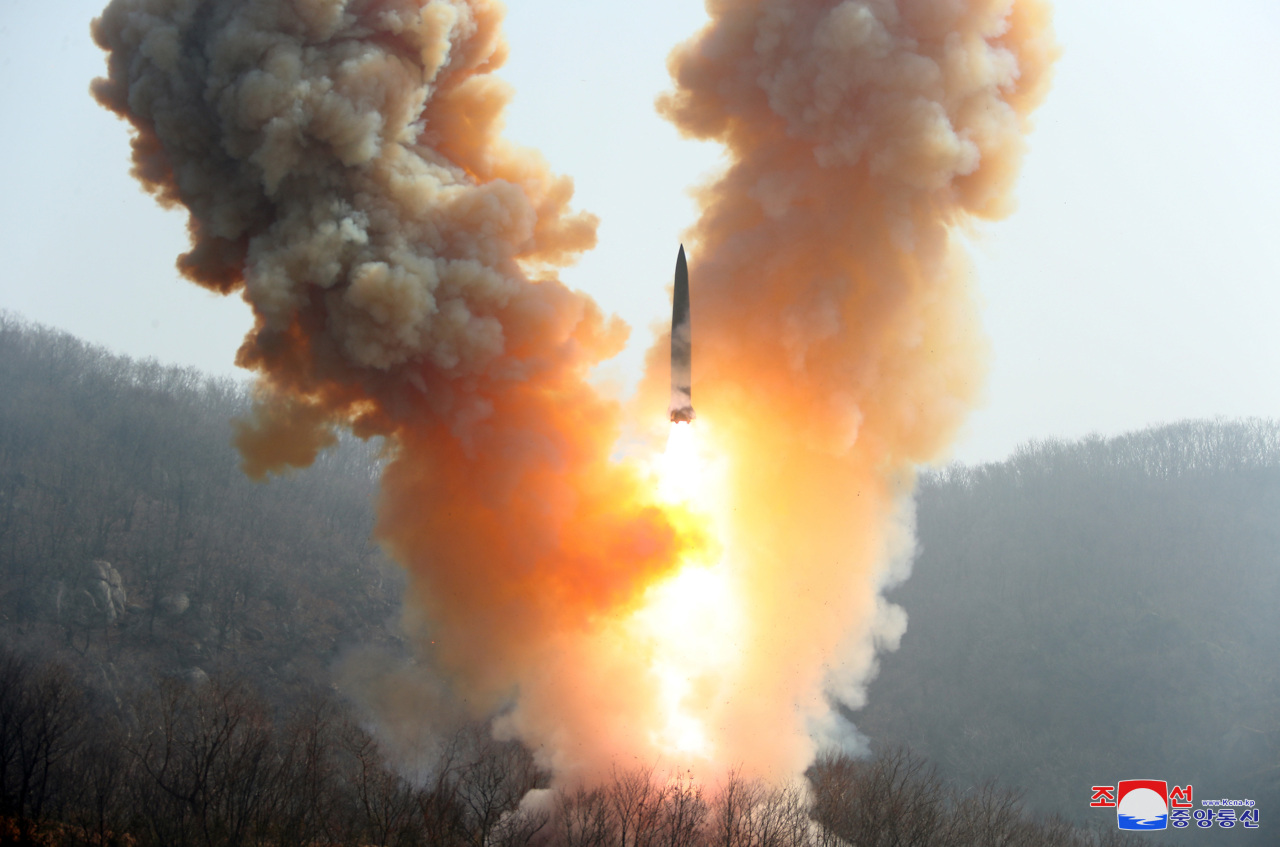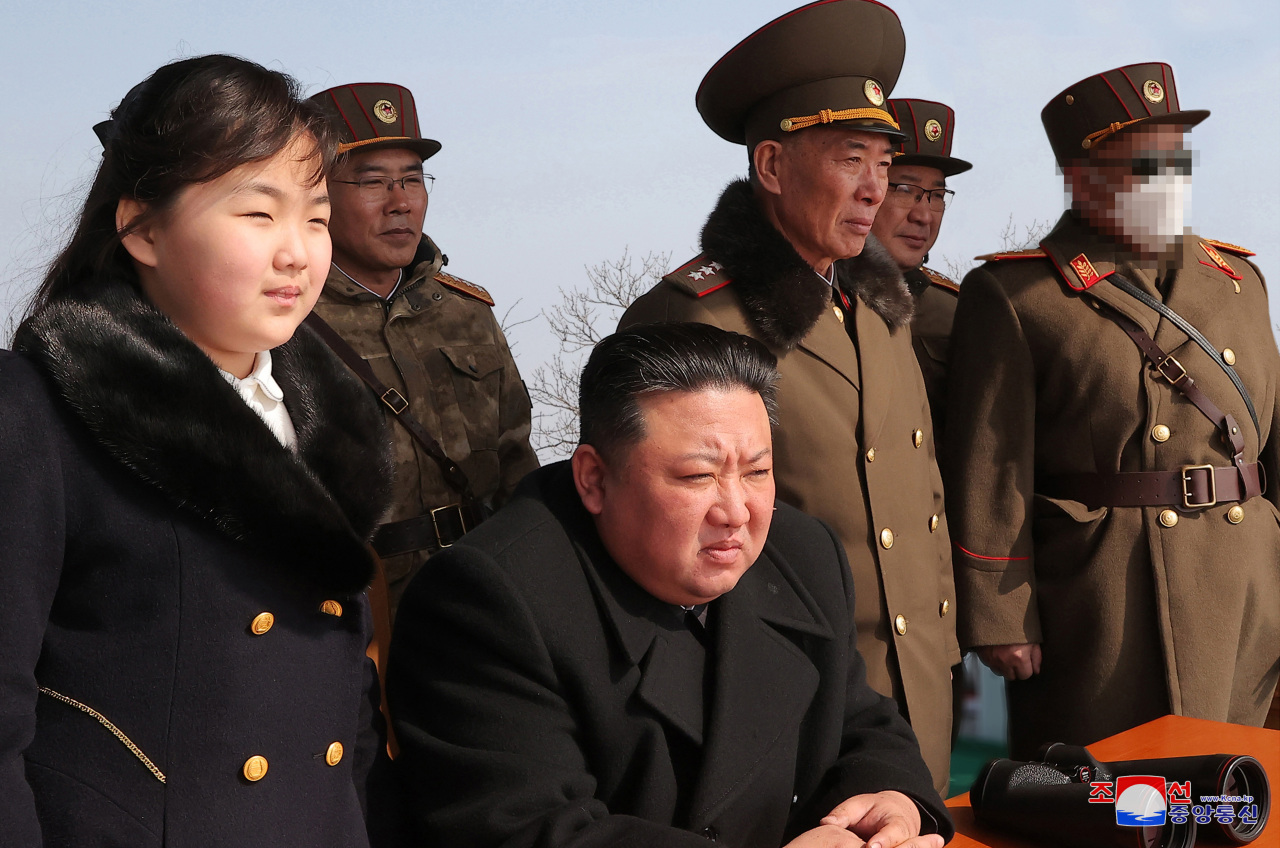N. Korea simulates nuclear air burst to attack S. Korea
By Ji Da-gyumPublished : March 20, 2023 - 15:09

North Korean leader Kim Jong-un guided the two-day “joint tactical drills simulating a nuclear counterattack by units operating tactical nuclear weapons” on Saturday and Sunday, North Korean state media reported Monday in a Korean-language dispatch.
The major purpose of the joint drills was to “substantially reinforce the country’s war deterrence and nuclear counterattack capability and make relevant unit master procedures and processes to carry out tactical nuclear attack missions,” according to North Korean state media.
The nuclear drills also aimed to “demonstrate North Korea’s tougher will to take countermeasures and send a stronger warning” to South Korea and the US as they are staging their own military exercises.
North Korea’s tactical nuclear operation units repeatedly practiced procedures to enforce the leadership’s orders to launch nuclear attacks on the first day of the drills. The military units staged a live-fire exercise “simulating launching nuclear attacks on key enemy targets” the next day, state media reported.
North Korean nuclear forces fired a ballistic missile tipped with a mock tactical nuclear weapon able to hit targets in South Korean territory, it said.
But state media notably reported that the “tactical ballistic missile accurately exploded in midair 800 meters above a designated target in the East Sea” after traveling around 800 kilometers, claiming that the test confirmed the “reliability of the operation of nuclear explosion control devices and detonators fitted in a nuclear warhead.”
Yang Uk, a research fellow in national security at the Asan Institute for Policy Studies think tank in Seoul, pointed out that North Korea’s “testing of the air burst intended to maximize destructive power is the country’s threat to attack major South Korean cities” with tactical nuclear bombs.
“Ground burst is generally used to destroy military targets including underground military installations,” Yang said. “Air explosion is utilized to maximize destructive power and spread damage, and therefore it is an appropriate method to attack especially dense urban areas with numerous buildings.”
The photos released by state media showed North Korea firing a KN-23 solid-fuel short-range ballistic missile possibly from an underground silo, according to military experts.
“If the missile was launched from an underground launch facility, known as silo, it shows North Korea’s pursuit to diversify its missile launch platforms,” said Kim Dong-yub, a professor at the University of North Korean Studies in Seoul.
Kim explained that a silo is susceptible to be targeted by an enemy if its location is disclosed, although it has the advantage of providing a stable launch platform.
“If North Korea seeks to build silos notwithstanding the weakness, it seeks to diversify its missile launch platforms ultimately to enhance the survivability of transporter erector launchers by dispersing origins of attacks subject to precision strikes of the US and South Korea.”
While guiding the nuclear drills, the North Korean leader underscored that the country’s war deterrence is effective only when armed forces maintain a “full readiness to swiftly and precisely launch nuclear attacks ... at any time,” adding that possessing nuclear weapons is not sufficient to that end.
North Korean state media reported the nuclear drills a day after the South Korean military said North Korea fired a short-range ballistic missile from the northwestern Tongchang-ri area, where North Korea’s main long-range ballistic missile and rocket launch facility is located, on Sunday morning. The missile flew around 800 kilometers across the country before falling into the waters off the eastern coast.

North Korea labeled the missile launches as live-fire drills to enhance the country’s war deterrence and tit-for-tat military actions against the alliance’s 11-day Freedom Shield exercise that began on March 13.
South Korea’s Vice Defense Minister Shin Beom-chul dismissed North Korea’s series of missile launches as a “calculated overreaction” to combined military exercises between South Korea and the US in his interview with local broadcaster SBS on Monday.
“My assessment is that North Korea portrays itself as a victim to (combined military exercises) and exploiting them as an opportunity to reinforce its nuclear capabilities,” Shin said.
Shin dismissed North Korea’s attempt to label “defense-oriented military exercises as provocative and threatening” as a pretext to continue military and nuclear buildup.
“But we should still keep an eye on continuing advancement of North Korea’s overall nuclear capabilities with concerns,” he said. “It is important for us to strengthen our deterrence more swiftly to build capability to counter nuclear threats that have been rapidly mounting.”
In another interview with Arirang TV, Shin said, “The Kim Jong-un regime, which has not been able to make economic achievements, also seeks to transmit propaganda messages that they have at least built nuclear forces in terms of internal political context.”








![[Kim Seong-kon] Democracy and the future of South Korea](http://res.heraldm.com/phpwas/restmb_idxmake.php?idx=644&simg=/content/image/2024/04/16/20240416050802_0.jpg&u=)








![[KH Explains] Hyundai's full hybrid edge to pay off amid slow transition to pure EVs](http://res.heraldm.com/phpwas/restmb_idxmake.php?idx=652&simg=/content/image/2024/04/18/20240418050645_0.jpg&u=20240418181020)

![[Today’s K-pop] Zico drops snippet of collaboration with Jennie](http://res.heraldm.com/phpwas/restmb_idxmake.php?idx=642&simg=/content/image/2024/04/18/20240418050702_0.jpg&u=)